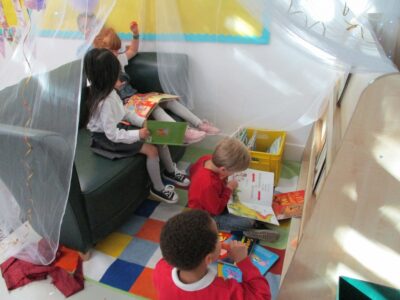When we recognise the sounds (phonemes) that letters represent and join them together we are decoding text and using phonics to read.
At Woodgrange we see systematic synthetic phonics as a key to accessing early reading. However we also believe this is only one of the strategies we use to be a reader and our Reading curriculum includes many different strands of reading skills and behaviours.
We use Phonics Bug to support teaching and learning in phonics.
Every child is taught a phonics every day until they are reading fluently.
Organisation
Phonics sessions are a daily 20-25 minute session taught in mixed ability whole class groups.Across reception and Year 1 there are 3 class groups and 1 group moving at a slower pace to allow children to reinforce their learning at a more appropriate pace. Any child with gaps in their understanding may have additional short sessions to help them catch up quickly.
The teaching Sequence
 We start to teach phonics in Nursery through songs, games, rhymes and stories. Sessions become more focused as the children move into Reception and are very sharply focused in years 1 and 2.
We start to teach phonics in Nursery through songs, games, rhymes and stories. Sessions become more focused as the children move into Reception and are very sharply focused in years 1 and 2.
Children learn sets of sounds as they progress through phases.
In Nursery children are learning in Phase 1
In reception children are learning in phases 2 through to 4.
We expect children to move rapidly through the remaining phases (up to 6) in key Stage 1. Once they have completed the programme children move swiftly on to a session that develops reading fluency and comprehension- we call this BOOK TALK.
Phonics at Woodgrange Infant School
Some words cannot be decoded- they are irregular e.g. was/ the/ go. These are gradually taught as sight words.
Wider reading skills
Children are taught to interrogate and understand what they are reading through Book Talk sessions. This is a mixed ability group session where adults ask structured questions to probe understanding- both literal- what? Where? and inferential why? what do you think…? questions.
As our curriculum is built around quality core books children have lots of opportunities to explore books, stories, poems and information text as an integral part of their learning.

